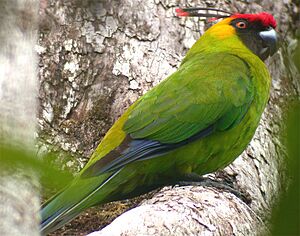Horned parakeet facts for kids
Quick facts for kids Horned parakeet |
|
|---|---|
 |
|
| Conservation status | |
| Scientific classification | |
| Genus: |
Eunymphicus
|
| Species: |
cornutus
|
The horned parakeet (Eunymphicus cornutus) is a special type of parrot. It belongs to the family Psittaculidae. This medium-sized parrot lives only in New Caledonia. It is called "horned" because it has two unique black feathers. These feathers stick out from its head and have red tips.
Contents
About the Horned Parakeet's Name
The horned parakeet got its official name in 1788. A German scientist named Johann Friedrich Gmelin first described it. He gave it the scientific name Psittacus cornutus. The word cornutus comes from Latin and means "horned." This name perfectly describes its special head feathers!
Later, scientists placed this bird in a different group, or genus, called Eunymphicus. This genus also includes the Ouvea parakeet. In 1998, DNA studies showed that the horned parakeet and the Ouvea parakeet are two different species.
What Does the Horned Parakeet Look Like?
Adult horned parakeets are about 32 cm (or about 14 inches) long. This length includes their tail. Like many parrots, they are mostly green.
This parrot has a yellowish area on the back of its neck. Its face is black and red, and its wings and tail are bluish. The most amazing part is its crest. It has two black feathers that stick up from its head. These feathers have bright red tips, making them look like little horns!
The horned parakeet makes a special sound. It has a nasal "kho-khoot" call to talk to other parakeets. It also makes many different shrieks and chuckles.
Where Do Horned Parakeets Live?
The horned parakeet lives only in New Caledonia. This means it is native to that one place. It prefers to live in rainforests and special laurel forests.
It also lives in humid pine forests. These are forests with specific types of pine trees, like Agathis and Araucaria pines. Sometimes, it can also be found in scrublands or savannas.
Horned Parakeet Behaviour
Horned parakeets usually live in small family groups or pairs. They spend their time looking for food high up in the trees. Their diet mostly includes nuts and seeds.
Reproduction and Life Cycle
Horned parakeets build their nests in different places. They might nest on the ground or very close to it. They also use hollowed-out logs or holes in dead trees. It's rare for parrots, but horned parakeets have been seen sharing nests.
A female parakeet usually lays 2 to 4 eggs. In captivity, the eggs hatch after about 21 to 22 days. The young birds stay in the nest for about 5 to 6 weeks after hatching. Then they are ready to fly.
Horned Parakeet Status and Protection
The number of horned parakeets has gone down since the 1880s. However, there are still some living in New Caledonia. Recent studies guess there are over 5,000 birds left.
Several things threaten these birds. These include black rats, wildcats, and Rusa deer that were brought to the island. Logging (cutting down trees) also harms their homes. A wet weather pattern called La Niña can also affect them. They can also get a serious virus called Psittacine beak and feather disease.
People rarely hunt these birds for pets. This is because their nests are hard to find. Also, it's not a common tradition in New Caledonia to keep these birds as pets.
The IUCN lists the horned parakeet as "Vulnerable." This means they are at risk of becoming endangered. They are vulnerable because they live in a small area and their numbers are decreasing.
Since 2000, the horned parakeet has been listed under CITES I. This means it is illegal to buy or sell these birds internationally. In 2014, the European Union also made it illegal to trade them within Europe. These parrots are also fully protected by the laws of New Caledonia.


